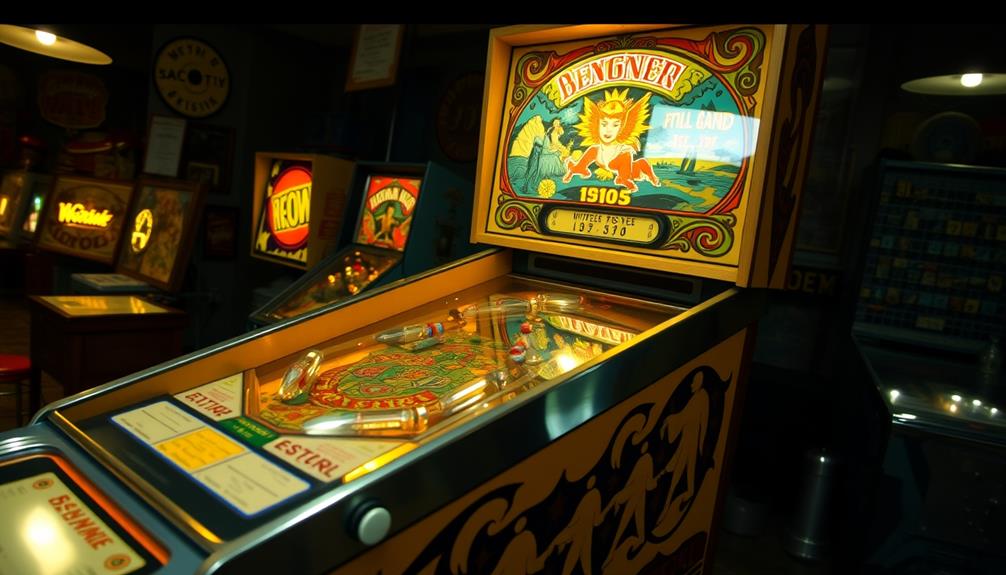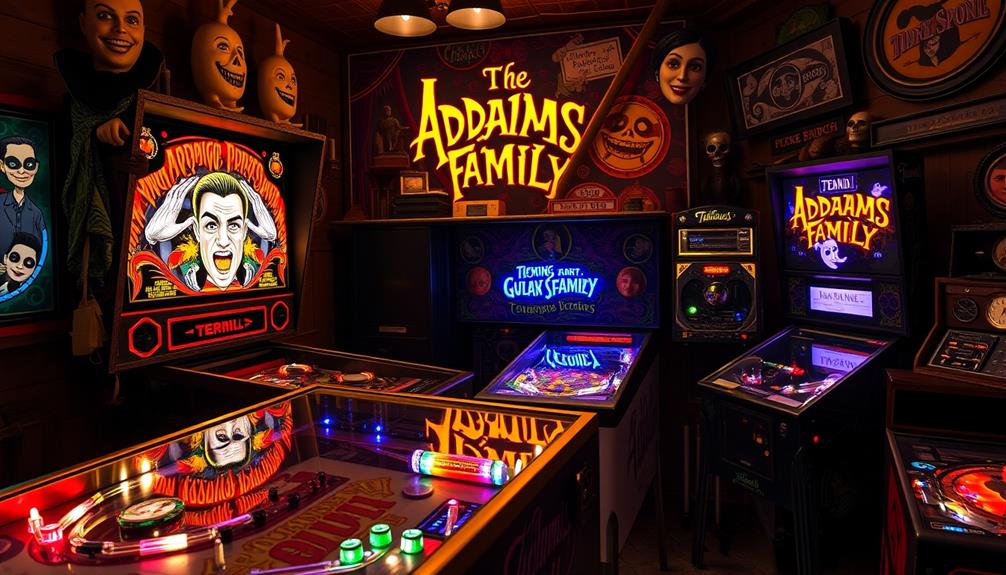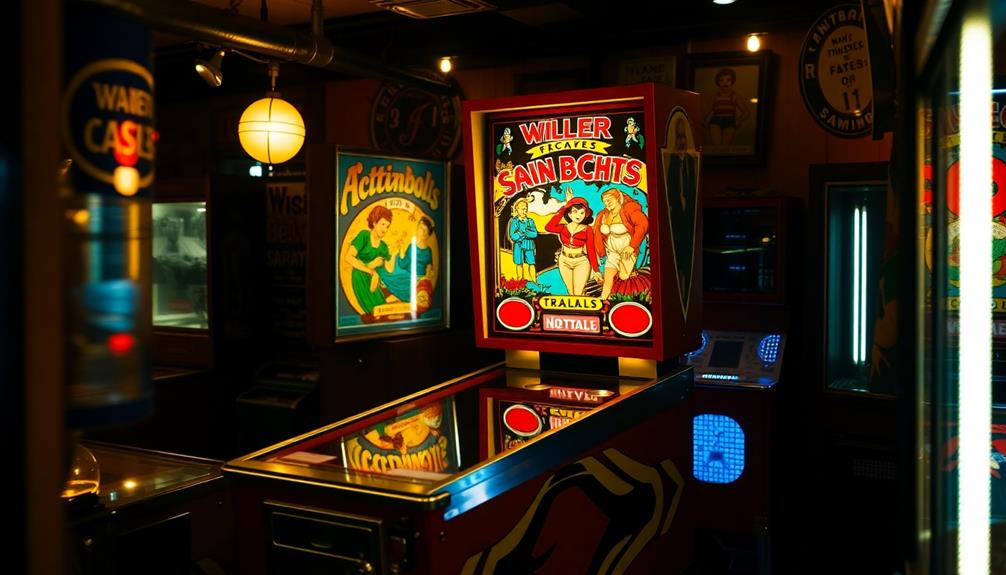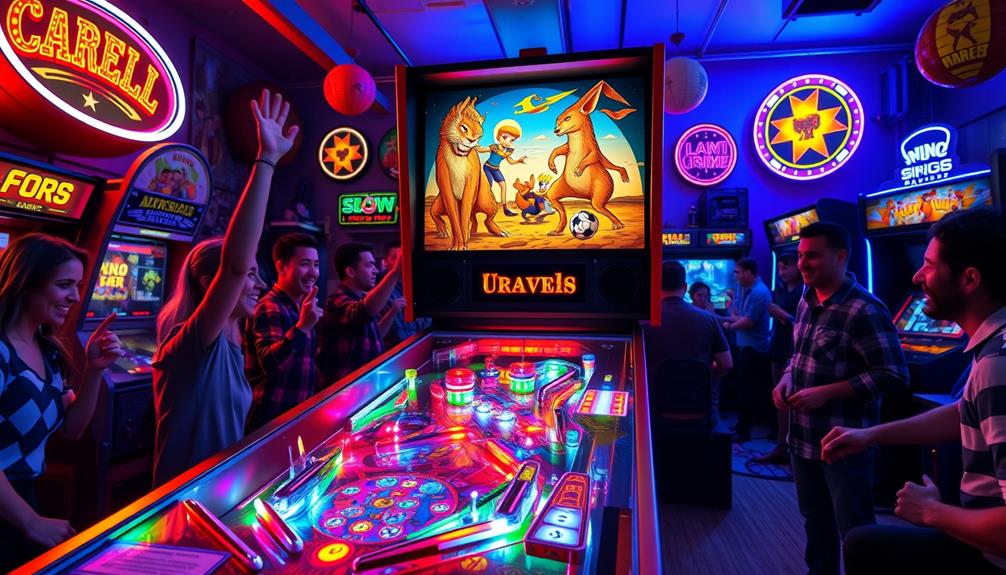The original pinball machine to look for is the “Baffle Ball”, which was developed by Gottlieb in 1931. This innovative machine revolutionized casual gaming during the Great Depression, drawing crowds to bars and amusement parks. While there were previous games like “Bagatelle” before “Baffle Ball”, it was Gottlieb’s creativity that marked the beginning of the modern pinball era. With its basic mechanics and wooden legs, “Baffle Ball” paved the way for future advancements, such as the incorporation of coin mechanisms in other machines. If you’re interested in learning about the evolution of pinball into the skill-based game it is known as today, there is much more to discover!
Key Takeaways
- The first pinball machine, "Baffle Ball," was created by Gottlieb in 1931, marking the beginning of modern pinball.
- "Baffle Ball" featured a simple design and mechanics, focusing on chance-based gameplay without flippers.
- Prior to "Baffle Ball," the game "Bagatelle" was patented in 1871, serving as a precursor to pinball.
- The term "pinball" was officially coined in 1936, defining the identity of the game as it evolved.
- "Whiffle Board," also produced in 1931, was the first coin-operated game, highlighting the emerging popularity of coin-operated machines.
Origins of Pinball Machines
The origins of pinball machines trace back to a blend of skill and chance that has captivated players for generations. The first pinball machine, known as the "Baffle Ball," was created by Gottlieb in 1931, marking the dawn of the coin-operated pinball era.
Before that, Montague Redgrave patented a precursor called Bagatelle in 1871, where players used a cue stick to shoot balls into holes, setting the stage for future innovations. Understanding the importance of budgeting for entertainment can enhance the enjoyment of such pastimes without financial strain.
By 1936, the term "pinball" emerged, solidifying the game's identity as players aimed to land balls into holes surrounded by pins. The introduction of the "Ballyhoo" machine in 1934 by Raymond Maloney was significant, as it incorporated a coin mechanism, making pinball gaming more accessible and popular.
Over the years, pinball machines evolved from tabletop versions of outdoor games, shifting from luck-based play to a true game of skill with the introduction of flippers in the late 1940s.
This evolution not only enhanced gameplay but also guaranteed that pinball remains a beloved pastime, merging both strategy and chance in an exciting way.
The First Coin-Operated Game

When you think about the first coin-operated games, the "Whiffle Board" from 1931 likely comes to mind as a pioneer in this domain.
This machine paved the way for later models like Ballyhoo, which introduced exciting features that shaped gaming culture.
The evolution of these early machines highlights the importance of high-quality content boosts credibility and trustworthiness in the gaming industry.
As you explore these early innovations, you'll see how they transformed the landscape of entertainment.
Origins of Coin-Op Machines
Coin-operated machines have a fascinating history, with their origins dating back to the early 20th century. The first coin-operated pinball machine, known as the Whiffle Board, was produced in 1931 by Automatic Industries. This groundbreaking tabletop design allowed players to launch balls into holes to score points, marking a significant moment in coin-operated gaming.
The charm and appeal of these machines contributed to their popularity, much like how astrology claims to influence personality traits and attractiveness.
You might feel a thrill reminiscing about those early days:
- The excitement of inserting coins and watching the action unfold.
- The simplicity of wooden legs and straightforward mechanics.
- The camaraderie built around these machines in arcades.
In 1934, the Ballyhoo model was introduced by Raymond Maloney, further solidifying the popularity of pinball.
By 1936, the term "pinball" gained traction, as the game became a staple in entertainment venues. These early machines, with their simple mechanics, laid the groundwork for what would evolve into the complex, steel-framed designs we see today.
The origins of pinball reflect a blend of innovation and nostalgia, enchanting players and paving the way for a beloved pastime that continues to thrive.
Early Models and Features
Early pinball machines featured simple yet engaging designs that captivated players. The first modern coin-operated machine, known as the "Baffle Ball," emerged in 1931, quickly gaining popularity for its accessible gameplay. Selling for just $17.50, it drew many players into the world of pinball.
Another notable early model, the "Whiffle Board," also appeared in 1931, showcasing basic gameplay mechanics where balls rolled into holes for scoring. These early machines had wooden legs and lacked the sophistication seen in today's steel designs, much like how various brewing methods can greatly impact the experience of coffee lovers. However, they laid the groundwork for the genre.
The introduction of electricity in 1934 was a game-changer, enhancing player engagement with sound effects and more dynamic gameplay features. This innovation transformed the gaming experience, making it more immersive and enjoyable.
Impact on Gaming Culture
The introduction of the first modern coin-operated game, the "Baffle Ball," revolutionized gaming culture and set the stage for pinball's widespread appeal. Launched in 1931 by Gottlieb, this simple yet engaging pinball machine transformed entertainment during the Great Depression.
Its accessible design, featuring a playfield with pins and holes, allowed players to shoot balls and earn points, drawing in crowds at bars and amusement parks. This innovation not only made gaming accessible to everyone but also highlighted the importance of nurturing an imaginative mindset in creating engaging experiences.
The impact of "Baffle Ball" was profound, leading to the proliferation of pinball machines and establishing a new form of social interaction.
Here's why it matters:
- It made gaming accessible to everyone, breaking social barriers.
- It fostered a sense of community as players gathered around machines.
- It sparked innovations that would shape the future of gaming.
Key Technological Innovations
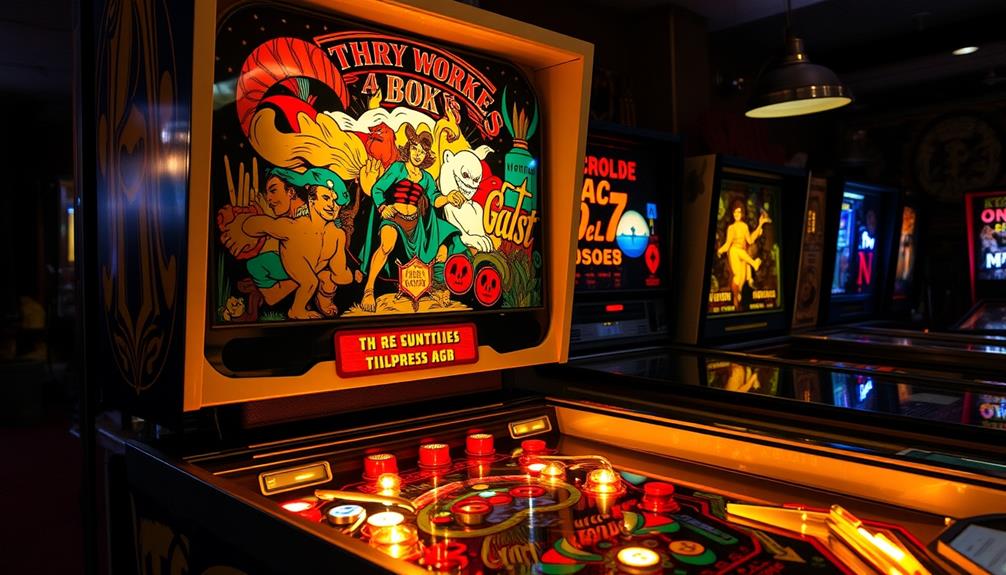
Pinball's evolution is marked by several key technological innovations that transformed it from a simple game of chance into a skill-driven experience. The introduction of Baffle Ball in 1931 set the stage with its groundbreaking coin mechanism and scoring system, making it the first modern coin-operated pinball machine.
In 1935, Harry Williams innovated the tilt mechanism, which enhanced game integrity by preventing cheating. This was a vital step in ensuring fair play. The excitement of the game was further enriched by the introduction of sound elements, much like the uplifting music that evokes joy and nostalgia.
By 1937, Bally's Bumper introduced coil bumpers, altering gameplay dynamics by allowing the ball to be propelled upon contact, adding excitement to the experience. The debut of the first electrically powered pinball machine in 1933 brought sound effects into the mix, using electromechanical bells and buzzers to enrich the gaming atmosphere.
A significant leap forward came in 1947 with Gottlieb's Humpty Dumpty, which introduced player-controlled flippers. This innovation shifted the focus from mere chance to skillful play, allowing players to influence the outcome of the game actively.
Together, these technological innovations laid the foundation for the engaging and competitive nature of modern pinball.
Evolution of Gameplay Mechanics
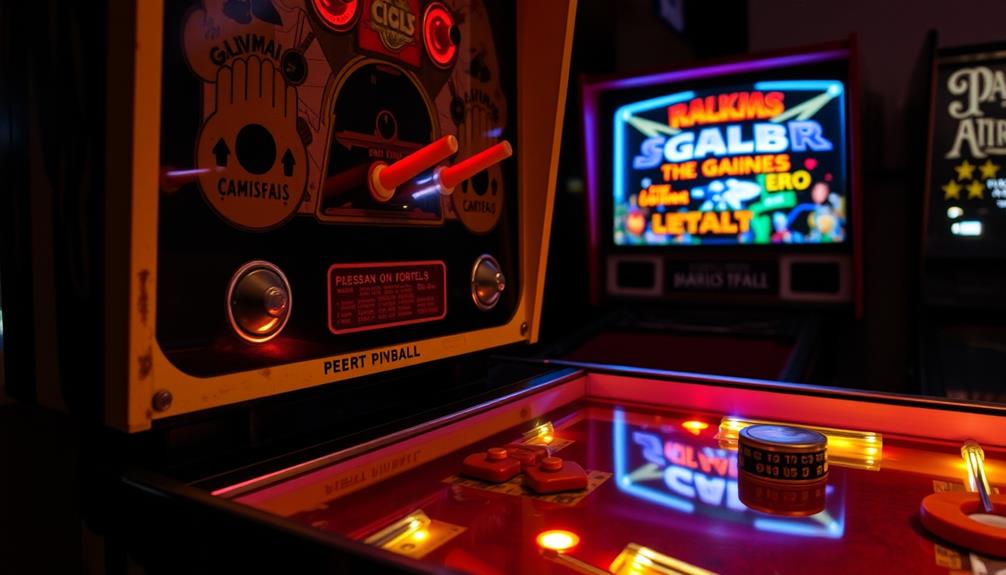
Since its inception, the gameplay mechanics of pinball have undergone remarkable transformations that enhance player engagement and challenge. The first modern pinball machine, Baffle Ball, introduced by Gottlieb in 1931, was a simple game of chance without flippers.
However, everything changed in 1947 with the introduction of flippers in Humpty Dumpty, allowing you to control the ball's trajectory and transforming the gameplay into a skill-based experience. This evolution parallels other competitive fields, such as the rise of young talents in sports, where innovations in training and technique can lead to significant advancements in performance, much like the developments in pinball rising talents showcase.
Key advancements over the years have included:
- The tilt mechanism introduced by Harry Williams in 1935, which added a layer of integrity by preventing cheating.
- The emergence of multiball play in the late 1960s, where you could manage multiple balls simultaneously, boosting your scoring potential.
- The shift to solid-state electronics in the mid-1970s, which revolutionized gameplay features by incorporating digital scoring and immersive sound effects.
These developments have made modern pinball machines not only more exciting but also a complex blend of strategy and chance, keeping players engaged and enthusiastic for the next challenge. This balance between skillful strategy and unpredictable chance ensures that no two games are ever the same, fueling the endless replayability that fans love. With their intricate designs and innovative features, it’s no wonder players often wonder how many pinball machines exist worldwide, each offering its unique themes and challenges. From vintage classics to cutting-edge digital hybrids, the world of pinball remains as vibrant and captivating as ever.
Impact on Popular Culture

Pinball's influence on entertainment venues transformed bars and arcades into social hubs where you could gather with friends.
The cultural significance of pinball machines can be seen in various aspects of celebrity lifestyles, where they often serve as a nostalgic centerpiece in private paradises, showcasing how art and interiors reveal collectible decor trends among celebrities.
You might recognize how iconic machines have left their mark in movies and TV shows, becoming symbols of fun and nostalgia.
Plus, the rise of competitive gaming communities showcases how pinball continues to engage players and spark excitement today.
Influence on Entertainment Venues
The introduction of the first modern coin-operated pinball machine in 1931 marked a significant turning point in entertainment venues, as it offered affordable amusement during the Great Depression. Baffle Ball set the stage for a new era of fun, transforming bars, arcades, and amusement parks into bustling hubs of social interactions, similar to the unique party options that enhance celebrations today.
Pinball machines quickly became essential fixtures, fostering competition and bringing people together. The introduction of flippers in 1947 shifted the game from mere chance to skill, capturing players' attention and making it a favorite pastime.
Consider the impact pinball has had on your experience at entertainment venues:
- Unforgettable social gatherings with friends, sharing laughs and friendly rivalries.
- The thrill of mastering a game, showcasing your skill as you aim for high scores.
- Iconic moments spent playing classics like The Addams Family, reminding you of the enduring legacy of pinball culture.
This blend of excitement and socialization has solidified pinball's influence across generations, ensuring its place in the heart of arcade culture and leisure activities.
Iconic Pop Culture References
As pinball machines became fixtures in entertainment venues, their influence began reaching far beyond the arcade. The first pinball machine, Baffle Ball, set the stage for an industry that would soon explode in popularity.
By the 1990s, iconic pinball machines like The Addams Family and Twilight Zone became cultural phenomena, solidifying their place in popular culture. These machines featured themed gameplay that not only attracted gamers but also captivated a broader audience, reflecting the same kind of love and charm seen in Paula Deen's wedding highlights.
Pinball's presence in films and television, such as its notable appearance in "The Who's Tommy," demonstrated its reach beyond just gaming. It became a symbol of nostalgia and entertainment, resonating with viewers on multiple levels.
This influence on popular culture has only grown with the resurgence of interest in retro gaming, leading to the creation of themed machines based on beloved franchises.
Today, pinball machines serve as a bridge between past and present, intertwining their legacy with contemporary pop culture. The blending of gaming and iconic references enriches the pinball experience, making it a timeless form of entertainment that continually evolves while paying homage to its roots.
Competitive Gaming Communities
In recent years, competitive gaming communities have transformed the landscape of pinball, turning it into a vibrant hub for enthusiasts and casual players alike. With structured formats like pinball tournaments organized by the International Flipper Pinball Association (IFPA), players now have the chance to showcase their skills and compete for exciting prizes.
This resurgence has fostered a passionate community that thrives on shared experiences and friendly rivalry. You might find yourself drawn to:
- The thrill of competing against skilled players from around the world
- The nostalgia of classic machines blending seamlessly with innovative modern pinball designs
- The camaraderie and friendships built through shared gameplay experiences
Events like the Pinball Expo and local tournaments attract hundreds of participants, celebrating both classic and modern pinball.
Social media and streaming platforms have amplified this vibrant culture, allowing pinball enthusiasts to share strategies, tutorials, and their gameplay experiences. Retro gaming's revival has sparked new interest in competitive pinball, creating a unique blend of nostalgia and modern excitement.
The Future of Pinball

Exciting advancements in technology are set to redefine the future of pinball, making gameplay more immersive than ever. As pinball machine manufacturers innovate with features like LED lighting and LCD monitors, you can expect thrilling interactive themes that elevate your gaming experience. The growing interest in retro gaming guarantees that both modern machines and classic pinball will thrive in arcades and home collections.
New manufacturers, such as Jersey Jack Pinball and Spooky Pinball, are emerging with fresh concepts that challenge established brands. These innovations will drive community events and tournaments, fostering a vibrant culture among enthusiasts.
Here's a glimpse of what's on the horizon:
| Feature | Description | Impact |
|---|---|---|
| Interactive Themes | Engaging narratives and gameplay | Attracts diverse audiences |
| Popular Franchises | Machines based on beloved movies | Boosts sales and interest |
| New Manufacturers | Innovative designs and concepts | Revitalizes the market |
| Community Events | Social engagement and tournaments | Strengthens player connections |
| Retro Aesthetics | Classic styles in modern machines | Appeals to nostalgia and tradition |
The future of pinball looks bright, with exciting opportunities for gamers like you!
Frequently Asked Questions
Why Was Pinball Illegal?
Pinball was illegal due to its gambling associations, as many machines offered cash payouts. Legislators feared addiction, especially among children, leading to crackdowns and legal battles over whether it was a game of skill or chance.
What Was the First Pinball Machine in the World?
You might find it fascinating that the first pinball machine emerged in the early 1930s. Its simple design involved launching balls into holes, creating a fun and engaging experience that captivated players and changed gaming forever. As the popularity of pinball grew, so did the history of pinball machines. Over the years, the machines evolved to include bumpers, flippers, and electronic scoring systems, making the game even more enjoyable and challenging. Despite facing bans and regulations in some regions, pinball machines have endured and continue to be a beloved pastime for players of all ages.
What Was the First Wide Body Pinball Machine?
When it comes to wide-body pinball machines, you've got to hand it to "Big Shot." Released in 1974, it featured a 30-inch playfield, paving the way for innovative designs and enhanced gameplay experiences.
Was Pinball Illegal in NYC?
Yes, pinball was illegal in NYC for decades, starting in 1942. Mayor La Guardia's crackdown classified it as gambling. It wasn't until 1976, after a skill demonstration, that the ban was finally lifted.
Conclusion
To sum up, the journey of pinball machines from their humble beginnings to the vibrant, interactive games you see today is truly fascinating. You've seen how these machines evolved, shaping not just gaming but also popular culture. Just imagine if those early players had smartphones in their pockets—they'd be sharing high scores on social media! As pinball continues to adapt and innovate, its legacy will surely keep drawing in new fans for generations to come.
